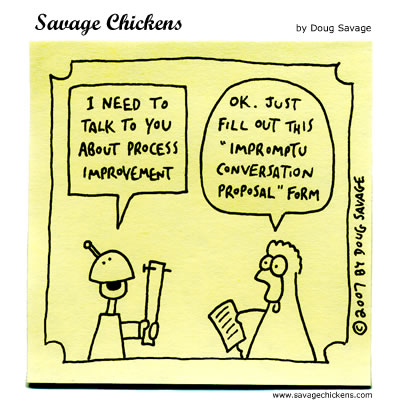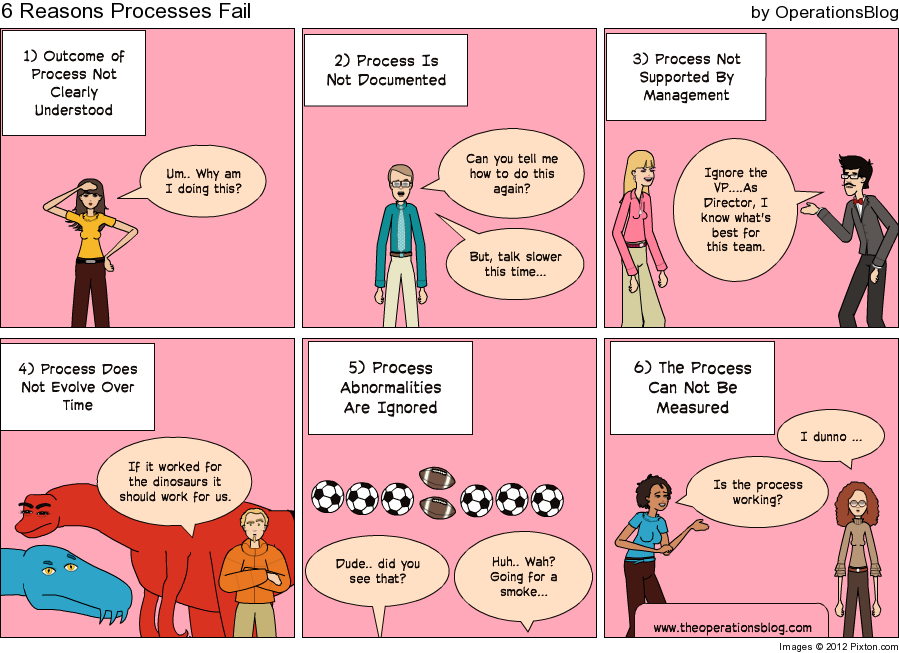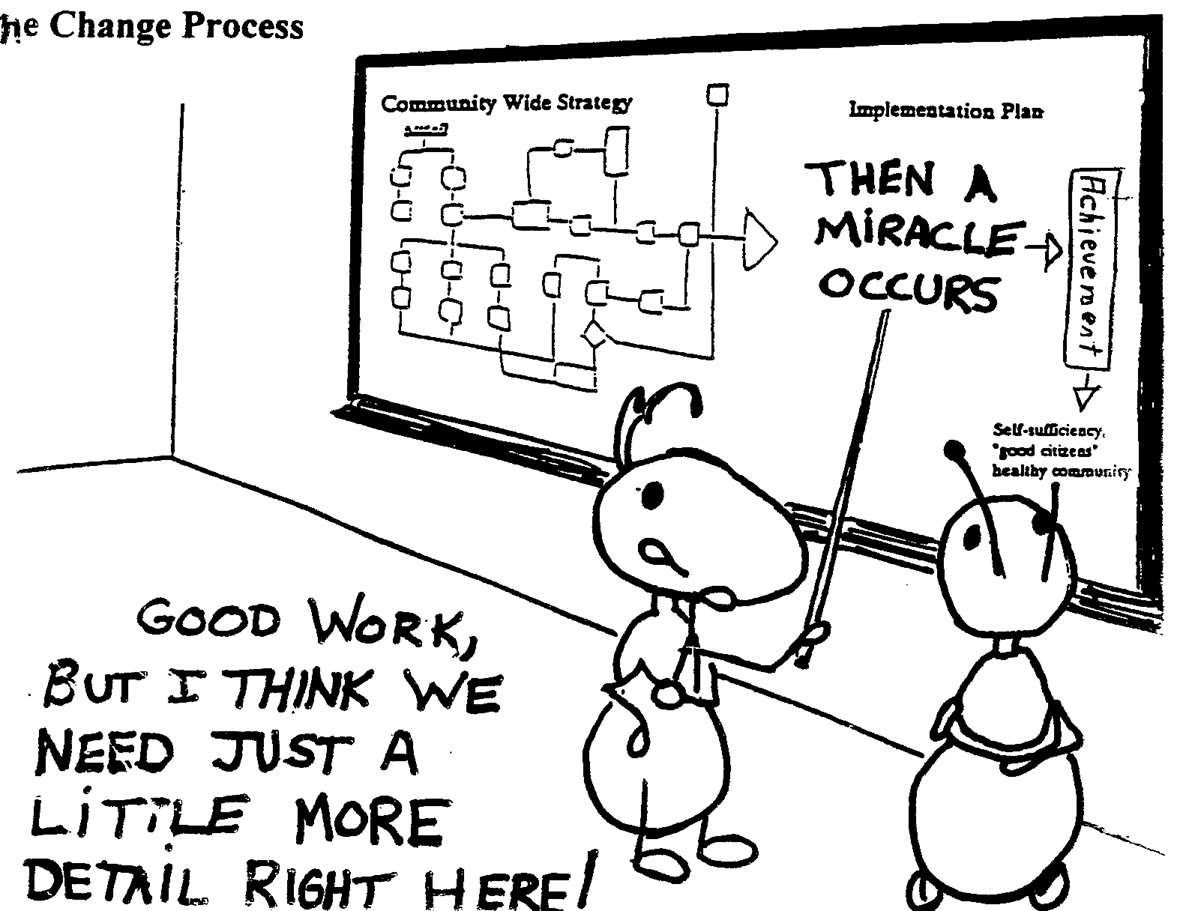Processes in start-ups are like the proverbial Men or Women – “You can’t Live with them! You can’t live without them!”.
Striking the right balance between having processes and not having them is an Art, not a Science. Getting them right in a start-up means all the difference between a surviving and thriving one, and one that chokes on itself either through chaos or rigidity!
When it is just the founding team and a small, tightly knit team working closely together, you don’t need a whole lot of processes. Everything just gets done informally by someone picking up the slack and doing it. It is when you reach a critical mass of 20 or more employees, fast growth or rising revenues that you suddenly need processes for everything. Not having them brings chaos, confusion, loss of goodwill with critical early employees, clients or customers!
At the same time, I have seen start-ups emulate large corporations too soon, and load up on process in the beginning, become rigid, and drive away good employees, valuable clients and customers. Right in the beginning when things looked so promising, and that’s not good either!
Whether it is Software Development Methodologies, Sales or Marketing, Customer Support or Human Resource management, processes become necessary with size. Keeping processes in control and making them work for you, rather than you working for them is the key!
,
Forms are the first signs of processes that show up and they are the bane of most start-ups! Like a form designed for an impromptu conversation proposal above!
 Processes fail for various reasons. Start-ups cannot afford to have processes fail! In large corporations, there is enough margins and cash flow, ( Of course, when they are doing well) that they can afford to absorb all kinds of process experiments, and failures before something works correctly! Start-ups need to get them right the first time! The margin for process failures is very thin! You cannot afford to waste any money, especially when you are on your way to revenues, and you are burning angel investments or hard-to-come-by venture money!
Processes fail for various reasons. Start-ups cannot afford to have processes fail! In large corporations, there is enough margins and cash flow, ( Of course, when they are doing well) that they can afford to absorb all kinds of process experiments, and failures before something works correctly! Start-ups need to get them right the first time! The margin for process failures is very thin! You cannot afford to waste any money, especially when you are on your way to revenues, and you are burning angel investments or hard-to-come-by venture money!
Luckily technology provides software product start-ups with various tools that can be leveraged. They can have the cake and eat it too! Here are seven such technologies that every start-up needs to look at seriously in rolling out processes smoothly and inexpensively, for the most part!
- The Internet: Web portals have enabled organizations business processes from order entry to logistics to customer service to be performed from anywhere, anytime by their employees. In some cases, these organizations are making these portals available even for their end-customers on an around-the-clock basis, making it very convenient. A good question to ask in any start-up while rolling out any process “Is there a way, the Internet can increase the process cycle efficiency for this business process?”. There are no excuses for not leveraging all kinds of Software As A Service (SaaS) sites from Software Development management to Customer Support and Service! Zoho, ChargeBee, Explara, FreshDesk, BaseCamp, etc., are all companies that any software start-up should explore and integrate in their processes!
- Wireless Connectivity: Can we wireless enable the people that form part any process? Can that delivery guy record that delivery using an application and data connectivity through his smartphone?
- Automated Workflow Systems: Automated workflow systems cut down the time, work items wait in a queue for processing. Many business processes suffer from wasteful physical movement of paper from desk to desk. When a piece of paper reaches the next destination, it waits behind other work items that arrived before it. Automated workflow systems can keep the work items moving, raising alerts if work items have been waiting for too long a time, re-routing themselves to others if someone is busy, etc. They also provide visibility into exactly where the bottlenecks may be in a business process, enabling sane Lean process improvement efforts to smooth these out. At a time when cloud-enabled workflow systems like Orangescape are available locally in India, there is simply no excuse!
- Scanning and Digitization: Computing and computer storage have become so inexpensive that many organizations scan and digitize most official documents that come in as paper. These may be legal documents or invoices from vendors of services, supplies, or raw material. Thereafter, it enables the circulation of these digital versions of these documents rather than wasteful movement of physical paper across the company. Digitization also enables processes to move geographically long distances effortlessly, enabling employees from geographically dispersed office locations to participate in the same workflow, for example.
- Service-Oriented Architectures: If an organization is using the most up-to-date transportation companies to handle its shipping needs, it can initiate a delivery from it own corporate applications seamlessly. These shipping companies have made their backend software systems accessible to any organizations’ software systems using service-oriented architectures (SOA). The SOA technology enables software systems in the same or disparate organizations talk to each other and exchange information automatically, without any human intervention. Many large corporations have realized enormous gains in process cycle efficiency in their supply chain business processes by allowing suppliers’ and customers’ software talk to their backend software systems using SOA. By enabling automatic exchange of data between organizations’ computers in an electronic form, SOA eliminates wasteful and time-consuming exchange of paper and redundant entry of data in to multiple computer applications.Checking out your local logistics vendor and seeing if you could integrate your order management system with their logistics systems over the Internet is something to be explored early on!
- Document Management Systems: Document management systems allow an organization to execute business processes that require collaboration across geographies, and even continents. They allow two people in different cities or countries to work collaboratively on a business process by making sure the changes they make are done in an orderly fashion and nothing is lost during the collaboration. Document management systems allow the check-out of documents for editing and require checking them back in once they are done. Thus changes made by different people on the same document are not lost. In many business processes, this has the potential of eliminating waste due to motion and most importantly the quality of the collaboration involved. In the absence of such systems, more time may be expended in sending documents back and forth by e-mail and coordinating changes made to the same documents by different people.
- Online CRM Systems/Self-Service FAQ Systems: Many organizations have placed customer relationship management (CRM) systems online as part of their web site. A customer can login and create a trouble ticket online for a support or service request instead of talking to a customer support representative on the telephone. Many organizations are using self-service frequently asked questions (FAQ) sections on their web sites where customers can see if their problem has been faced by other customers, and what the solution was, in those cases. These systems enable the speed up of customer service and support processes. FAQ sections on company web sites may even eliminate service or support calls if they answered their questions or solved their service or support problem. They are convenient for end customers since they are available on the Internet, around the clock, providing even better service than when done manually by telephone. Make the client/customer do the work! Many times they may not mind since they can do it 24/7 in their pajamas and don’t need to reach a human being to serve themselves!

Processes in start-ups can only be rolled out after a great deal of thought, especially, “is it absolutely necessary?”. But once it is deemed necessary, these days technologies and especially inexpensive, SaaS based offerings make it easy for them to implement them and make them work very effectively!
You can live with them, after all, if you know what you are doing and find the easiest, most effective way of doing them!













